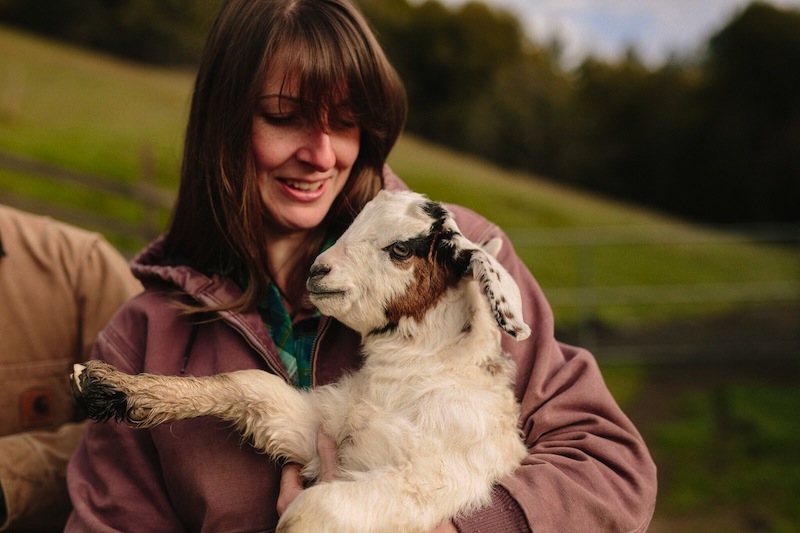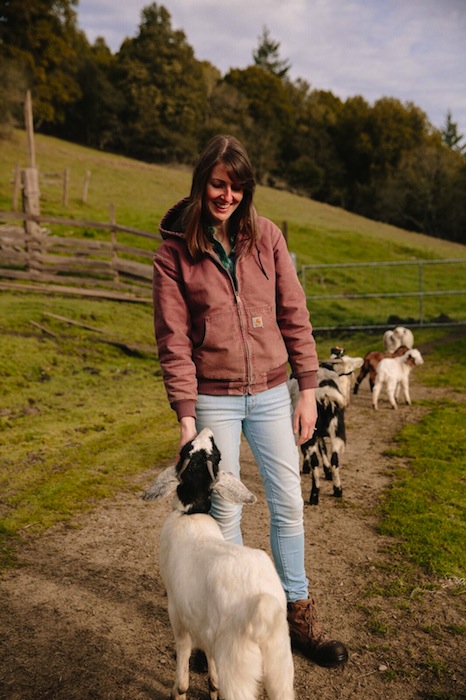Succession isn’t always easy—even when it’s all in the family.
Across from the old Watson School in Bodega, on a steep, craggy swath of land peppered with grazing meadows and dense wooded patches, sits a house built in 1917.
“If we don’t take care of this land, we’re failing these people here,” says the house’s owner, Ché Casul, pointing to portraits of his great-great-great-great grandparents who purchased the land in 1851. The photos hang in a place of honor above Casul’s dining room table.
“We eat under them every night and remember that this place isn’t just ours but our children’s and their children’s,” adds the 30-year-old rancher. A nearby window looks out on a small slice of the original 2,000 acres acquired by Casul’s family more than a century ago.
In Sonoma County, it’s not unusual to see agricultural families pass their operations down through the family lineage. And, it would appear that lots of younger folks are carrying on family farming traditions. But the numbers tell a different story. For years, the average age of primary operators on farms and ranches in the United States has hovered at 58.3. Despite an upswell of enthusiasm for local agriculture, according to the 2012 USDA agriculture census, the average age of farmers in Sonoma County is 60.1. So what gives?
According to farmers, ranchers and those that aid intergenerational transitions, the challenges to a smooth succession of operations revolve around three issues: The family’s ability to communicate and negotiate with each other, the high value of land in Sonoma County, and the difficulty of running a viable agricultural business in our local economy.
Casul is the most recent steward of his family’s remaining 213 acres. Casul’s grandmother and mother chose to live much of their lives in Berkeley, away from the ranch. Yet, even with the skip in generations, the desire to steward the Bodega ranch endured.
“It was always clear that we’d never sell it,” says Che’s mother, Mela Angleman.
After growing up as a “city kid” who frequently visited the ranch, Angleman and her husband Algeo Casul permanently relocated to the Bodega property in the early 1980s. They felt a pull to take care of the land and to raise a family there. They invested in infrastructure, fixed up the houses, and experimented with growing Christmas trees and purple potatoes. Still, without a background in animal husbandry, full-time ranch life wasn’t in the cards; the couple kept their day jobs, leasing the surrounding land for cattle grazing.
Their son Ché, who was a ranch kid, had different ideas, especially after he met Joe Pozzi, a rancher who owned acreage next door. Pozzi ran cattle on land leased from the Angelmans and had a daughter about the same age as Casul. Both kids grew up working with the livestock—docking tails, mending fences, and administering vaccines. In time, Pozzi became a mentor to Casul.
“Joe showed me that ranching isn’t planning for the almighty dollar,” says Casul. “You’re planning for what you can do for the next generation.”
Joe showed me that ranching isn't planning for the almighty dollar. You're planning for what you can do it for the next generation
At the age of 23, Casul moved back to ranch. Soon, his wife Angela joined him, also taking on a stewardship role. The couple slowly built up a small livestock operation. They currently have 52 goats and two small herds of sheep and cattle. Right now, they mainly sell goats “on hoof” to local Latino and Kenyan customers. The goat business is “ascending dramatically,” but, after seven years, the couple’s financial gains remain nominal. In other words, not enough for either to quit their day jobs. Casul says he’s learning to balance his desire to be a full-time rancher with realistic risk-taking.
“We’re not real ranchers quite yet, but one day I’ll be a Joe Pozzi,” says Casul.
The return of the younger generation to family land is paramount to keeping more of that land in agricultural production, according to Pozzi. His own family has been ranching in Sonoma County since the 1800s. After completing his education at Chico State University, Pozzi returned to the ancestral ranch. He became the fourth generation to run the family business. If things work out, his daughter Alexandra will be next. It may have been easy to pass down the business in his own family, but Pozzi has witnessed enough family transfers by other people to know that it can be a trying process, both legally and personally—a truth, he says, that’s reflected in a former agricultural landscape with more houses and subdivided lots than open space.
“Most of [the challenge] is not financial,” Pozzi says. “It’s important that the two generations that are in the transition process are willing to discuss it openly. If they’re not in agreement, and attorneys get involved, it can go sideways really fast.”
As the former president of the Sonoma County Farm Bureau, Pozzi has seen up close how land value directly impacts the amount of acreage taken out of agricultural production—a fact he admits reduces our overall food security and environmental well being. While he believes that the majority of established operators with viable businesses will continue to figure out how to pass them on, land sold to the highest bidder doesn’t usually come back into production.
“Once it’s sold or let out of the family, you will probably never see it again,” he says.
A family business has a unique organizational structure that differs from a large corporation where “one person gets out of a desk and another sits down,” says Rod Carter, a Chico-based business consultant to farmers, ranchers, and agri-businesses who specializes in succession. Typically, the family business organization isn’t formal, nor is it immune from interpersonal dynamics between family members.
When George Davis, 74, decided to “semi-retire,” 10 years ago, he sold three-fourths of the interest in Porter Creek Vineyards, his biodynamic vineyard operation, to his son Alex. He also sold his son a portion of the land. Planning for the transfer of the business into Alex’s hands was a bit like open heart surgery, says Davis.
“You’ve got the family business, and all of these connections with it,” says Davis. “You have interfamily resentments to work out. It’s not an easy process.”
Up north in Mendocino County, the Magruder family came up with a creative solution as a way to bypass any potential issues when it came time for the older generation to retire. It all started after Grace Magruder Farmer, 34, decided that she wanted to return to her family ranch after a stint on the East Coast for graduate school. As fate allowed, she found a partner who also wanted to live the rural life. These days, her husband Kyle, and their two small children, work alongside Grace’s dad, Mac, in the field and the office. Still, Grace and her sister Martha never felt pressure to follow in their father’s footsteps.
“I grew up always knowing that the ranch would pass to my sister and me,” says Farmer. “But my parents were really good at not putting any sort of expectation on me saying that you must come back.”
Her sister Martha feels strongly attached to the land but lives in Los Angeles where she’s pursuing an acting career. Sometimes siblings’ different goals can lead to irreparable rifts, but the Magruders were able to separate their business into an L.L.C. and put the land into a family trust. This allows Grace and Kyle to buy into the business as managing members. The land will pass on to the sisters as a separate entity.
“That is how we’re handling the trickiness of one on-farm [sibling] and one off-farm,” says Farmer. “We’re the first generation in our family that has done that.”
Farmer admits that she has an advantage as a young producer in an area known for notoriously expensive land prices. Like the Casul and Pozzi families, she didn’t come up against perhaps the greatest challenge facing beginning food producers in Northern California: access to land.
“I didn’t have to think, how am I going to find land and money” admits Farmer, “I don’t know if I would have had the guts to do this otherwise.”
Ché Casul, whose neighbor just sold 500 acres for $19 million, echoes this feeling.
“If I didn’t have the land, I would absolutely not be doing it,” he says.
This financial reality has fostered creativity not only within families but also amongst land trusts and support organizations. Marin Agricultural Land Trust (MALT) and Sonoma County Land Trust (SCLT) have helped facilitate conservation easements on agricultural land that can either be sold or donated, sometimes resulting in property tax savings. With this kind of easement, the land’s potential for development is removed too, meaning that the property’s market value goes down and, in turn, lowers estate taxes. According to the Land Trust Alliance, this can make a critical difference in the heir’s ability to keep the land intact.
Another model involves the mentorship and education of first-generation farmers and ranchers, land-owning and not. The Farm Bureau (including the Young Farmers and Ranchers Program), 4H, and Future Farmers of America train the next generation and provide scholarships to anyone interested in developing agricultural skills.
Miriam Volat, co-director of the Permaculture Skills Center (PSC), says these beginning farmers and ranchers are also drawn to their 12-week Farm School training program from around the world. Students are paired up with a mentor farmer or rancher for at least six months. The paid mentors and the students don’t always look like the traditional beginning/retiring pair. Some Farm School students are experienced business people who have decided to switch careers, and some of the mentors have only been farming for a few years.
Yet, as increased interest in food production pushes up against the challenge of gaining access to farm land, creative approaches to succession are vital to passing on precious land-based knowledge.
“We are at a real risk of missing out on the opportunity,” says Volat. “We can’t take advantage of the culture shift that’s happening because we’re totally constrained by what’s happening with real estate.”
Evan Wiig, executive director of the Farmers Guild, also believes in creativity. This means letting go of the idea that the family farm is irrevocably tied to a piece of property.
“A lot of young farmers get so hung up on that concept, but land ownership is different from being a successful farmer,” he says.
A new farmer can’t always count on taking over the land they’re working on, but they can walk away with a different form of capital—the business itself and the relationships that come of it.
Earlier this year, the Farmers Guild merged with the Community Alliance with Family Farmers (CAFF), an organization that has been working with farming families since 1978. Together, they have made intergenerational exchange a main goal for this next year.
Whatever model succession takes, the ultimate goal is for each generation to feel fulfilled and at peace with their decisions. Ideally, the transition allows the elder generation to enjoy retirement and explore other parts of their lives.
That’s how it’s worked out for Mela Angleman. She still works as a nurse practitioner, and says that as long as she can continue to run yoga classes in her old redwood barn, she is happy to hand over stewardship of the Bodega acreage to her son and free up some of her responsibilities.
“It’s all coming around, as it should,” she says.




